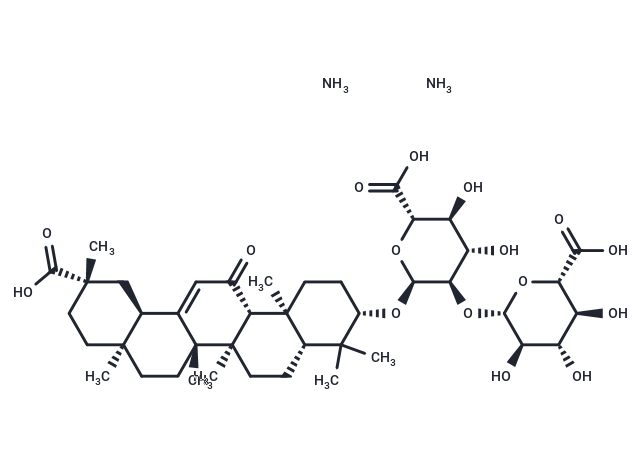Shopping Cart
- Remove All
 Your shopping cart is currently empty
Your shopping cart is currently empty

Diammonium Glycyrrhizinate (Glycyrrhizin) , an extensively used anti-inflammatory agent, is isolated from the licorice root. It is metabolized to glycyrrhetinic acid, which inhibits 11-β-hydroxysteroid dehydrogenase and other enzymes involved in the metabolism of corticosteroids. Therefore, glycyrrhizic acid, the main and sweet component of licorice, has been studied for its ability to cause hypermineralocorticoidism with potassium loss and sodium retention, edema, increased blood pressure, as well as inhibited the renin-angiotensin-aldosterone system.

| Pack Size | Price | Availability | Quantity |
|---|---|---|---|
| 20 mg | $35 | In Stock | |
| 1 mL x 10 mM (in DMSO) | $50 | In Stock |
| Description | Diammonium Glycyrrhizinate (Glycyrrhizin) , an extensively used anti-inflammatory agent, is isolated from the licorice root. It is metabolized to glycyrrhetinic acid, which inhibits 11-β-hydroxysteroid dehydrogenase and other enzymes involved in the metabolism of corticosteroids. Therefore, glycyrrhizic acid, the main and sweet component of licorice, has been studied for its ability to cause hypermineralocorticoidism with potassium loss and sodium retention, edema, increased blood pressure, as well as inhibited the renin-angiotensin-aldosterone system. |
| Kinase Assay | In vitro kinase assay [1]: Tyrosine kinase assays are performed by HTRF (KDR, VEGFR1, FGFR1, c-Met, EGFR) and ELISA (PDGFRβ), using the recombinant kinase domains of receptors. In both assays, 4 μL of serial dilutions of E7080 are mixed in a 96-well round plate with 10 μL of enzyme, 16 μL of poly (GT) solution (250 ng) and 10 μL of ATP solution (1 μM ATP) (final concentration of DMSO is 0.1%). In wells for blanks, no enzyme is added. In control wells no test article is added. The kinase reaction is initiated by adding ATP solution to each well. After 30-minute incubation at 30°C, the reaction is stopped by adding 0.5 M EDTA (10 μL/well) to the reaction mixture in each well. Dilution buffer adequate to each kinase assay is added to the reaction mixture. In the HTRF assay, 50 μL of the reaction mixture is transferred to a 96-well 1/2 area black EIA/RIA plate, HTRF solution (50 μL/well) is added to the reaction mixture, and then kinase activity is determined by measurement of fluorescence with a time-resolved fluorescence detector at an excitation wavelength of 337 nm and an emission wavelengths of 620 and 665 nm. In the ELISA, 50 μL of the reaction mixture is incubated in avidin coated 96-well polystyrene plates at room temperature for 30 minutes. After washing with wash buffer, PY20-HRP solution (70 μL/well) is added and the reaction mixture is incubated at room temperature for 30 minutes. After washing with wash buffer, TMB reagent (100 μL/well) is added to each well. After several minutes (10–30 minutes), 1 M H3PO4 (100 μL/well) is added to each well. Kinase activity is determined by measurement of absorbance at 450 nm with a microplate reader. |
| Alias | Diammonium Glycyrrhizin |
| Molecular Weight | 857 |
| Formula | C42H62O16·2H3N |
| Cas No. | 79165-06-3 |
| Smiles | N.N.C[C@]12CC[C@@](C)(C[C@H]1C1=CC(=O)[C@@H]3[C@@]4(C)CC[C@H](O[C@H]5O[C@@H]([C@@H](O)[C@H](O)[C@H]5O[C@@H]5O[C@@H]([C@@H](O)[C@H](O)[C@H]5O)C(O)=O)C(O)=O)C(C)(C)[C@@H]4CC[C@@]3(C)[C@]1(C)CC2)C(O)=O |
| Relative Density. | no data available |
| Storage | Powder: -20°C for 3 years | In solvent: -80°C for 1 year | Shipping with blue ice. | ||||||||||||||||||||||||||||||||||||||||
| Solubility Information | DMSO: 15 mg/mL (17.5 mM), Sonication is recommended. H2O: 116.7 mM, Sonication is recommended. | ||||||||||||||||||||||||||||||||||||||||
Solution Preparation Table | |||||||||||||||||||||||||||||||||||||||||
DMSO/H2O
H2O
| |||||||||||||||||||||||||||||||||||||||||

Copyright © 2015-2025 TargetMol Chemicals Inc. All Rights Reserved.